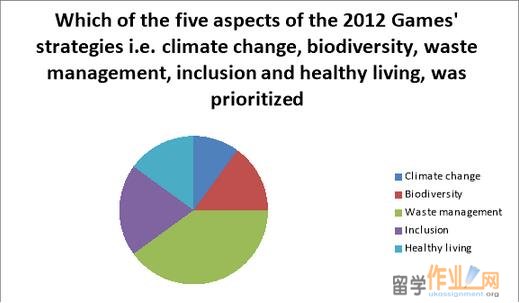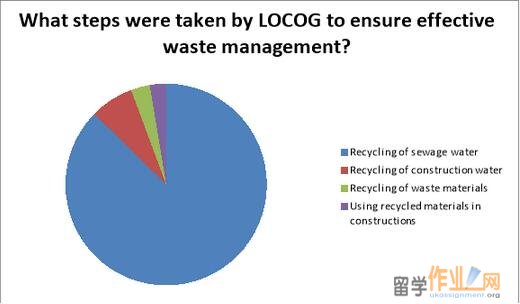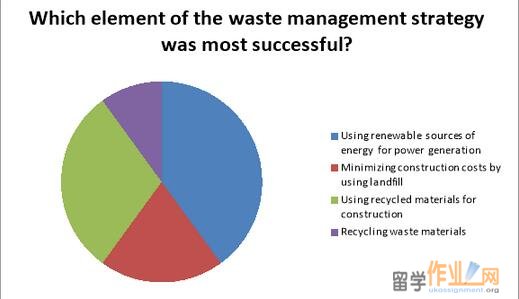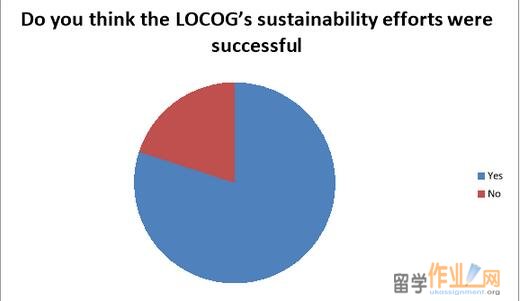|
奥林匹克运动会在1896年开始,有十四个国家参加.。2012夏季奥运会于7月27日至8月12日在伦敦举行.。这是第三届夏季奥运会在伦敦举行。伦敦奥运会组委会负责该项目,它专注于使奥运会持续。创建一个有效的可持续发展计划。伦敦奥组委关注可持续性五个方面。这些都是气候变化,废物,生物多样性,包容性和健康生活。本文的目的是评估在2012伦敦奥运会奥组委的废物管理计划的实施。
奥运会综述:
奥运会是国际性的体育比赛,在许多不同的体育和学科,与来自世界各地的运动员参与。这是每四年举行一次。古代奥运会在希腊奥林匹亚举行。夏季和冬季奥运会每四年举行一次.。直到1992,他们总是在同一年举行。但目前,他们已经转变。一个独立但附属的组织是国际象棋奥林匹克。第一个现代体育游戏承载奥运品牌,是英国的奥运会。
Executive Summary: 执行摘要:
The Olympic Games began in the year 1896 and fourteen nations took part in it. The Summer Olympic of 2012 took place in London from 27th July to 12th August. This was the third Summer Olympic Games that was held in London. The committee London Olympic Games Organizing Committee (LOCOG) was responsible for the event, and, it focused on making the games sustainable. The concept of “One Planet Living” was incorporated into the event in order create an effective sustainability plan. LOCOG focused on five aspects of sustainability. These are climate change, waste, biodiversity, inclusion, and healthy living. This paper aims to evaluate the waste management plan of LOCOG implemented in the 2012 London Olympic Games.
An overview of Olympics Games:奥运会综述:
The Olympic Games are collective international sports competition in many different sports and disciplines, with the participation of athletes from around the world. It is held every four years (McCrae, 2012). The predecessor model is the ancient Olympics, held in Olympia in Greece. Summer and Winter Olympic Games are held every four years. Until 1992, they had always been held in the same year. But currently, they have been shifted so that one comes two years after the other. A separate but affiliated organization is the Chess Olympiad. The first modern sports games bearing the Olympic brand, was the English Olympic games, which was hosted in 1604 by Robert Dover at his country house in the Cotswold. King James I was a large supporter and promoter of the sport. He decided that the games were to be held every year at the summer solstice (Georgescu-Roegen, 2007). The program involved running disciplines, hammer throw, ball games, wrestling and fencing poles. Both nobles and commoners attended the games, and some disciplines even allowed women to participate. The games ended 40 years later with the death of its founder. The first one who came out with the idea of restoring the Olympics was a German educational reformer Johann Bernhard Basedow in 1760. Another great promoter of the resurrection of the Olympic Games was Johann Christoph Friedrich GutsMuths. Under the influence of many physical education organizations, sports events began under the name Olympics. The committee has the sole decision making authority. From 1900 onward, women had been participating in the Olympic Games. Presently, the IOC (International Olympic Committee) has the responsibility of organizing the events.
London Olympic Games 2012:伦敦2012奥运会:
2012 Summer Olympics, officially the Games of the XXX Olympiad, were the Olympic Games held in the city of London, from 27 July to 12 August 2012. London was the first city to officially host the Olympic Games of the Modern Era three times - the previous ones were in 1908 and 1948. On 15 March 2007, Tessa Jowell announced in the House of Commons, that a budget of 5.3 billion (5300 million) pounds was needed for stadium construction and infrastructure for the Games (Rosner & Shropshire, 2012). It was also announced that the reform of urban Lower Lea Valley would need a budget of 1.7 billion pounds. Funding was provided by the British public sector and by LOCOG. In total, a value of 11.3 billion pounds was achieved. 9.3 billion pounds came from the public sector and 2 billion pounds came from LOCOG (Topping, 2012). Public sector funding breakdown is as follows:
6.2 billion from the Central Government;
2.2 billion from the National Lottery;
875 million of the city of London.
LOCOG funding breakdown:
700 million pounds came from sponsorship of 42 companies;
700 million from the International Olympic Committee;
600 million pounds from the sale of tickets.
In November 2007, Edward Leigh, criticized the organizers for underestimating the cost of staging the Games, suggesting they had "acted in bad faith or were incompetent".
In June 2007, the Ministerial Group which was created to manage the effects for the Olympic Development Authority Greater London - got together and made the first estimated budget of the Games. They were be left with 360 million pounds and a reserve of 500 million was needed if spending more was needed. On November 26, 2007, the founders of the Ministerial Group eventually approved the original budget proposed by the Olympic Authority. The total cost of the budget was 6.9 billion pounds, including what was to be raised from taxes and excluding general program reserves, which was announced in March. This includes a donation to the ODA of the remaining 140 million from the first reserve of 500 million (McCarthy, 2012).
Overview of the Sustainability Plan: London Olympics 2012:
The London Olympic Games Organizing Committee (LOCOG) prioritized sustainability and implemented the “One Planet Living” theory in its plans. The sustainability efforts of the LOCOG involved five elements - climate change, waste, biodiversity, inclusion, and healthy living. These have been evaluated as follows:
Waste Management 废物管理
Waste management was one of the most important elements of the sustainability plan of the London Olympic Games 2012. The LOCOG used several strategies to ensure efficient waste management. Strategies were designed specifically to make sure that wastes were minimum. Also, most of the wastes were recycled and reused. The structures of construction were disassembled in order to make sure that the recovery rate was high (McCarthy, 2012). These steps made the waste management effective.
Inclusion 包含
The LOCOG made sure that the games involved people from all the various communities of London and the close regions. People from a huge variety of groups and communities became parts of the organization process. The plan prioritized diversity, and made the games accessible. The LOCOG facilitated social, economic and physical improvement of the areas (Ayres, 2008). Over 1500 people were employed during the constructions. Also, LOCOG made sure that women were included in the process. More than 500 women worked with the LOCOG. LOCOG also involved students through various participation programs. The inclusion strategy allowed the communities to become parts of the planning and organizing process. LOCOG also allowed people from local communities to see the Olympic sites before the commencement of the games.
Healthy Living 健康生活
The LOCOG promoted health living through the London Olympic Games 2012. LOCOG increased awareness about increasing fitness through various programs. It insisted peole should walk or cycle to the venues and not drive there. It also provided cycles to the workers in order to make sure they became more fit (Gabel, 2012).
Biodiversity 生物多样性
Biodiversity was an important part of the sustainability plan of LOCOG. The goal was to make the Olympic park habitable. The LOCOG made sure that new wildlife was created at the park. Specific habitats and species were established at the park. The habitat and species were monitored, reported and assessed continuously to make sure that the area has been sustainably rehabilitated (Gra, 2012).
Climate Change 气候变化
The Committee minimized carbon emissions related to the games. It promoted eco-friendly lifestyles and practices, and increased awareness about different environmental threats. Renewable energy sources were used in the construction as well as the event. Pollution was minimized and there was minimum waste. The LOCOG focused on making the games environment friendly. The committee had made plans to bring down emissions by 50% and had been able to ultimately reduce it to 47% mark. This is a considerable achievement (Gabel, 2012). It had provided cycles to workers so that they would not drive to the construction sites and offices, in turn, minimizing emissions. Energy efficiency was ensured to make sure that environmental impact were low. Power was assessed real time to keep energy consumption low. This also made sure that energy was fully utilized and wastage was low. An optimum energy usage point was established through technology. This made sure that the energy could not cross the pre fix limit. The LOCOG also established a lot of spaces with greeneries (Rosner & Shropshire, 2012).
Sustainability plan developed by LOCOG in London Olympics 2012: A study of the Waste Management Plan:
The London Organizing Committee of the Olympic Games (LOCOG) used specific strategies to ensure effective waste management. Its primary objective was to cause minimum damage to the environment. 97% of the construction wastes were used for landfill (Kinver, 2012). The LOCOG also ensured that wastage was minimal in the overall events. A dedicated landfill policy was adapted to make sure that wastes were nil. LOCOG also recycled wastes in order to reuse them for different purposes. The plan was to reuse 70% of waste materials. The plan proved to be highly successful as LOCOG successfully recycled 73% of the wastes. This achievement was beyond expectations and set a new benchmark in waste management. Before this, the recycling volumes were quite low in other Olympic Games. The average amount of recycling done in all previous Olympic Games was just 15% (Koopmans, 2006). The LOCOG established new standards of recycling that is sure to inspire all future hosts of the games. The next organizers will have to live up to the standards set by LOCOG, and will have to improve the waste management even further. The LOCOG established numerous waste bins in order involve people in its waste management and recycling efforts. Volunteers, security personnel, etc. were posted at several locations to make sure that the crowds do not drop wastes all over the venue. This made sure that the audiences dropped wastes only in the bins. In turn, the venues were kept extremely clean. However, the bins were not divided into categories. There was no specific bin for objects that can be recycled. All wastes were put in the same bins. This made recycling tough. Yet, LOCOG successfully managed the wastes at the games (Cook, 2012).#p#分页标题#e#
The LOCOG also ensured that the water used in the games was recycled. The water needs of the constructions, as well as the event, were met through recycling. The dirty water of a sewage plant was recycled for this purpose. The water also helped in irrigation and flushing of the bathrooms. Rainwater was collected through special equipment and green roofs were established. This ensured that rain water was stored efficiently. But, the recycled water was not adequate for drinking purposes. LOCOG also set up rainwater collecting systems and green roofs in order to store water. However, recycling waste water was not enough to provide sufficient water for drinking purposes. The LOCOG planned to use renewable sources of energy to meet its power requirements. Its goal was to get 20% of the power it needed, from renewable sources of energy (Macur & Pfanner, 2011). It established a wind turbine for this purpose. It also used recycled bio fuels. But, finding such fuels was tough. In spite of its dedication, LOCOG failed to meet its target of 20% power supply from renewable sources of energy. It only got 9% energy. Yet, this can be considered to be a success as the renewable energy sources provide just 3% of the power in entire UK. LOCOG used waste management strategies in construction too. Its buildings used virgin steel (IOC, 2013). The Olympic Park was constructed on old and abandoned gas pipes in order minimize wastage. Two thirds of the steel was recycled steel. This diminished the construction costs by half a million pounds. The London Olympic Games used just 10% of the amount of steel that was used in the Beijing Olympic Games. The ’Velodrome’ of the Olympic Games was created with recycled timber. Natural light and ventilation was used to ensure sustainability. The aquatics area involved concrete and steel, but the area was quite sustainable (IOC, 2013).
Opinion Survey: 民意调查:
A survey of 100 students was done to understand the opinions about the effectiveness of the sustainability plan of LOCOG. The random sampling method was used to select the participants of the survey (Bryman, 2012).
At first, the respondents were about their views on the aspect of sustainability, which was given highest priority by the LOCOG. 10% of the students stated that they thought that the LOCOG put maximum efforts on climate change. 15% students stated that biodiversity was given the highest priority. 40% of them stated that waste management was the aspect which saw most efforts. 20% of the respondents stated that inclusion was given the most important. The rest stated that healthy living was given most importance by LOCOG.

The second question focused on identifying the strategies used by LOCOG to make sure that waste management was good. 20% of the respondents stated recycling of sewage water was an important strategy. 10% of them stated that recycling of construction water was a good strategy. 40% stated that using recycled raw materials for constructions was one of the most effective strategies implemented by LOCOG.

After this, the students were asked about the scale of success of the waste management strategies implemented by LOCOG. 40% of them stated that using recycled materials for construction was an excellent strategy. 20% of the respondents stated that involving renewable sources of energy was an effective strategy. 30% of them stated that reducing construction expenses through landfill is one of the most successful strategies.

The fourth question focused on identifying the drawbacks of the waste management efforts of LOCOG. 25% of the students pointed out that LOCOG’s failure to keep separate dustbins for recyclable materials was a flaw. 30% of them pointed out that failure to find adequate bio fuels was a major drawback. 35% of them stated that failure to provide sufficient water through recycling participants was a flaw. The rest 5% stated that LOCOG had failed to incorporate sufficient recycled materials in constructions.

The last question focused on assessing whether the students thought that LOCOG’s sustainability efforts were successful or not. 80% of the respondents stated that LOCOG was successful, while 20% stated that it had failed.
Conclusion: 结论
It can be concluded from this paper that the LOCOG prioritized sustainability. Under its waste management plan, the focus was on minimizing wastes. Numerous dustbins were installed all through the premises of the Olympic Park and other locations related to the games. Volunteers, security personnel, etc. made sure that the audiences did not make the premises dirty. Waste was minimized by removing, recycling and reusing 97% of the construction wastes. 73% of the entire wastes were recycled and reused. The constructions also used a lot of recycled materials. LOCOG also used renewable sources of energy to get power. It used very low quantities of steel. It used recycled water and stored rainwater to meet the water needs. Overall, this paper points out that, the LOCOG have been quite successful in its waste management efforts and, it has set a very good example. The students, who took part in the survey, pointed out some drawbacks. LOCOG’s failure to keep separate dustbins for recyclable materials was a flaw. Its failure to find adequate bio fuels was a major drawback. The failure to provide sufficient water through recycling participants was a flaw too. Yet, the students stated that LOCOG’s sustainability efforts were successful and considered LOCOG’s waste management strategies to be effective (Gabel, 2012).
|
 |
|||
| 网站地图 |

